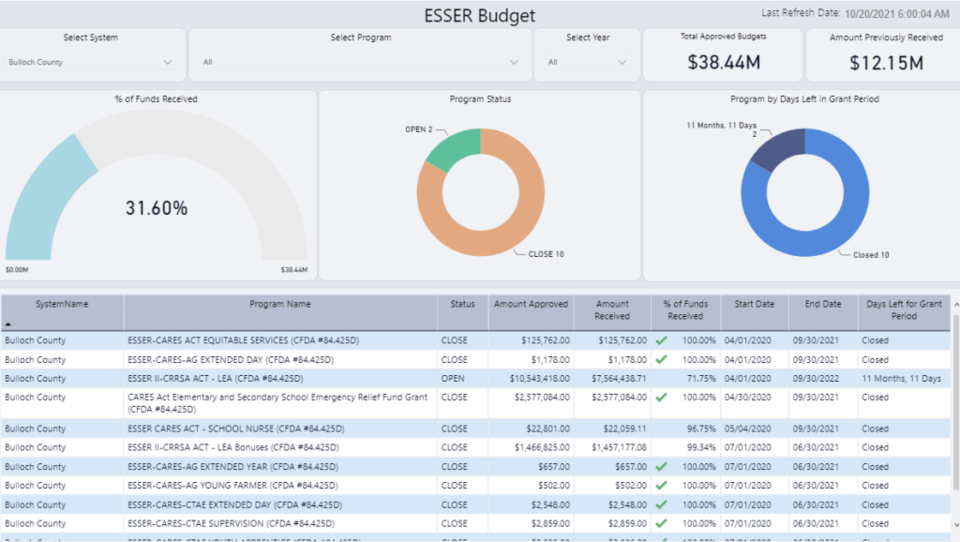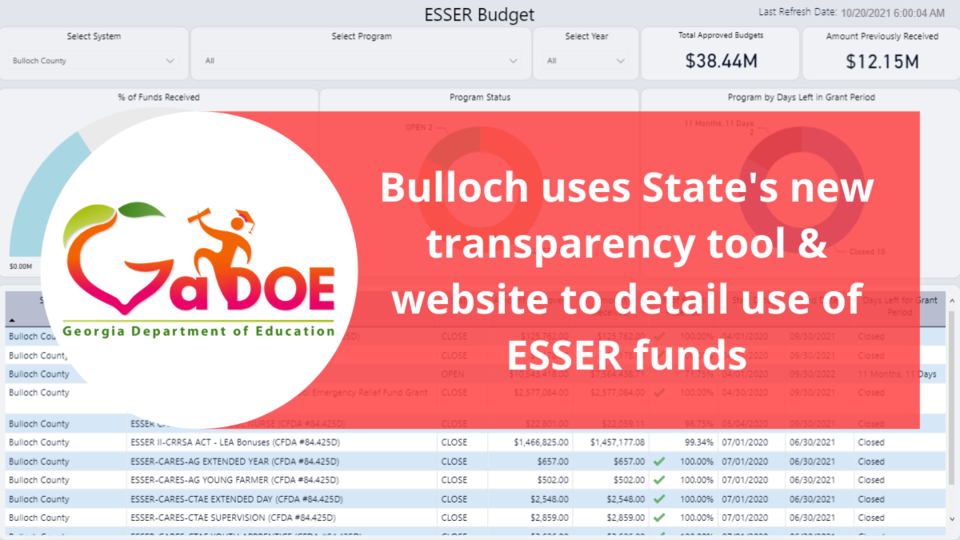GA launches public dashboard to track school districts’ COVID-19 relief funds
Bulloch County Schools, through its website, provides the community access to the state’s new online dashboard for tracking Elementary and Secondary School Emergency Relief (ESSER) Funds to Georgia school districts. These federal relief funds were allotted to school districts to help sustain operations during the COVID-19 pandemic, address student learning loss, and assist with economic recovery.


The Georgia Department of Education developed the tool within its COVID-19 resources website to provide the public a simple, transparent way to review the federal funds for their school district and any supplemental relief funds the state chose to give districts. The state launched the website and announced it to the public on September 29. The school district launched its webpage with local access to the information the same day in the Business Services, Accountability, and COVID-19 Dashboard area of its website..
The new state dashboard shows the amount of Elementary and Secondary School Emergency Relief funds a school district has received, the amount of the submitted budgets that have been approved, and the time remaining for each grant period.
Required Accountability for the Funds
School district’s are required to present budgets to the state for how they plan to use their allotted relief funds. Districts then expend their own resources first to implement those plans, and then request reimbursement from the state. School districts did not receive the federal relief funds as direct lump sum payments.
Amount of Federal Relief Funds Allotted
Georgia school districts have received three rounds of Elementary and Secondary School Emergency Relief Funds – through the CARES Act in May 2020, the Coronavirus Response and Relief Supplemental Appropriations Act in January 2021, and the American Rescue Plan in March 2021.
In total Georgia school districts received $5,938,770,343 in federal relief funds. Twenty percent of the third round of funding must be used to address student learning loss; the remainder of the funds are flexible and can be used to support at-risk student populations, distance/remote learning, school meals, mental and physical health, supplemental learning, facilities and equipment, continuity of core staff and services, and more.
Bulloch County Schools will receive $36.8 million in federal Elementary and Secondary School Emergency Relief funds:
- $2.6 million from CARES Act I
- $10.5 million from CARES Act II
- $23.7 million from American Rescue Plan Act
In addition to these funds, the state utilized an additional $1,466,825 from its federal relief funds in March 2021 to be used for bonuses to teachers and other educators, and an additional amount of $156,601 to reimburse the school district for previous cuts in state funding. As a result the total amount of relief funds allotted to Bulloch County Schools is $38.44 million.
How Will the Federal Relief Funds Be Used in Bulloch County
Bulloch County Schools will budget its federal relief funds strategically to sustain the school district's financial stability during uncertain economic conditions and to prioritize recovery from the learning crisis that developed as a result of the COVID-19 pandemic.
It is specifically using the funds to support at-risk student populations, the distance learning and Virtual Learning programs, school meals, mental and physical health, supplemental learning, facilities and equipment, continuity of core staff and services, and more.
During the Board of Education's Fiscal Year 2022 Budget preparation and approval process, which began in January 2021, Troy Brown, the school district's assistant superintendent of business services, provided the Board a series of presentations that detailed and reviewed how funds would be budgeted and used over the next five years.
- Fiscal Year 2021 (July 1, 2020 - June 30, 2021)
- Utilized CARES I and II funds to offset the deficit budget due to state funding cuts and increased operational costs associated with the pandemic and to strengthen the district's financial position.
- Fiscal Year 2022 to 2025
- Utilize funds to increase the school district's general fund balance to sustain the district through the next three to five years while we address learning gaps and navigate uncertain economic conditions.
- Budget funds in order to sustain these efforts over the long-term so that the district does not have to prematurely halt needed student support efforts.
- Utilize the American Rescue Plan Act set aside funds to intentionally address student learning loss.
- Utilize American Rescue Plan Act funds to continue to offset state funding cuts and strengthen financial position.
- Structure the use of the federal funds with state and local funds to maximize flexibility.
Accountability & Evaluation
According to a news release issued by the Georgia Department of Education, the Georgia Partnership for Excellence in Education will partner with the state to examine the use of ESSER funds in Georgia to disseminate best practices throughout the state. Running through June 2025, the goals of the project are to do the following:
- Understand how districts use federal relief funds and the impact they have on district practice and, where feasible, students;
- Generate knowledge and lessons learned about student support strategies – academic and nonacademic – deployed by districts including a focus on those that boost staff and organizational capacity, leverage internal and community resources, and are embedded into district practice to maximize sustainability;
- Surface information on factors that influence the selection and implementation of support strategies, which may include district capacity, leadership changes, external constraints, or community input;
- Identify compelling stories from Georgia schools about the pandemic’s impact on students and how educators are meeting their needs; and
- Provide a shared-learning network for community leaders to learn from each other and raise awareness of best practice work already happening across the state of Georgia through the Georgia Partnership for Excellence in Education’s established Rural Learning Networks.
The project will include surveys of all school districts in 2022, 2023, and 2024 to capture information on their use of federal COVID-19 relief funds; stakeholder interviews to more closely examine issues identified in the survey; developing case studies with an in-depth analysis of the use and impact of funds; and stakeholder roundtables, briefings, and presentations to lift up best practices and what’s working in Georgia school districts.




